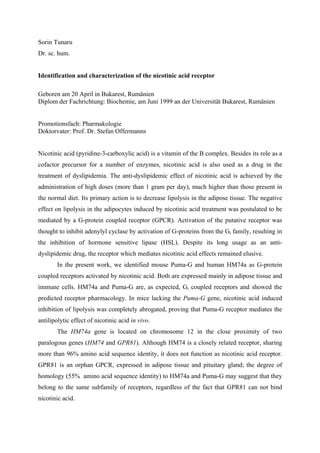
Sorin_Tunaru PhD summary
- 1. Sorin Tunaru Dr. sc. hum. Identification and characterization of the nicotinic acid receptor Geboren am 20 April in Bukarest, Rumänien Diplom der Fachrichtung: Biochemie, am Juni 1999 an der Universität Bukarest, Rumänien Promotionsfach: Pharmakologie Doktorvater: Prof. Dr. Stefan Offermanns Nicotinic acid (pyridine-3-carboxylic acid) is a vitamin of the B complex. Besides its role as a cofactor precursor for a number of enzymes, nicotinic acid is also used as a drug in the treatment of dyslipidemia. The anti-dyslipidemic effect of nicotinic acid is achieved by the administration of high doses (more than 1 gram per day), much higher than those present in the normal diet. Its primary action is to decrease lipolysis in the adipose tissue. The negative effect on lipolysis in the adipocytes induced by nicotinic acid treatment was postulated to be mediated by a G-protein coupled receptor (GPCR). Activation of the putative receptor was thought to inhibit adenylyl cyclase by activation of G-proteins from the Gi family, resulting in the inhibition of hormone sensitive lipase (HSL). Despite its long usage as an anti- dyslipidemic drug, the receptor which mediates nicotinic acid effects remained elusive. In the present work, we identified mouse Puma-G and human HM74a as G-protein coupled receptors activated by nicotinic acid. Both are expressed mainly in adipose tissue and immune cells. HM74a and Puma-G are, as expected, Gi coupled receptors and showed the predicted receptor pharmacology. In mice lacking the Puma-G gene, nicotinic acid induced inhibition of lipolysis was completely abrogated, proving that Puma-G receptor mediates the antilipolytic effect of nicotinic acid in vivo. The HM74a gene is located on chromosome 12 in the close proximity of two paralogous genes (HM74 and GPR81). Although HM74 is a closely related receptor, sharing more than 96% amino acid sequence identity, it does not function as nicotinic acid receptor. GPR81 is an orphan GPCR, expressed in adipose tissue and pituitary gland; the degree of homology (55% amino acid sequence identity) to HM74a and Puma-G may suggest that they belong to the same subfamily of receptors, regardless of the fact that GPR81 can not bind nicotinic acid.
- 2. Based on the high degree of sequence identity between HM74a and HM74 and by using a computer modelling approach together with site directed mutagenesis we characterized the putative binding pocket of HM74a receptor for nicotinic acid. Non- conserved residues N86, W91 (located within TMH2/ECL1 junction) and also S178 (ECL2) are critically involved in nicotinic acid binding. We further identified conserved residues R111 in transmembrane helix 3 (TMH3), F276 and Y284 (both located in TMH7) as additional residues forming the binding pocket. By screening chemical libraries, we found a family of compounds with selective agonistic activity on HM74 receptor: 2-oxo- and 2-hydroxy-octanoic acids are highly specific agonists of HM74 but not of HM74a receptor. Moreover, the specificity of 2-oxo-octanoic acid for HM74 receptor seems to be directed by the non-conserved residues located on ECL1, as shown by studies of chimeric HM74a and HM74 receptors. Although the endogenous ligand(s) for HM74a, HM74 and GPR81 still remain(s) unclear, the identification of HM74a and Puma-G as receptors for nicotinic acid and also the identification of a highly specific HM74 receptor agonist may help to understand the biological role of this family of receptors and provide a new basis for the development of lipid-lowering drugs.